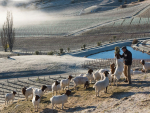Next Generation Viticulture: Capture more light to harvest more grapes
Transforming canopy management systems to maximise sunlight could increase vineyard profitability without compromising wine quality, says researchers.
Changes in world vineyard areas could reflect the international influence of Marlborough’s Sauvignon Blanc wine style.
Professor Kym Anderson has surveyed the world wine industry and collated an impressive database of which varieties are grown where, with surveys in 2000, 2010 and 2016.
While there was a progressive decrease in world vineyard area from 4,887,629 hectares to 4,483,128ha between 2000 and 2016, the increase in Sauvignon Blanc vineyard was impressive, doubling in area from 65,190ha to 124,700ha between 2000 and 2016. Sauvignon Blanc was ranked the 10th most widely grown wine grape variety in the world in 2016, up from 18 in 2000. This increase in area was the fourth largest after Tempranillo (126,900ha), Cabernet Sauvignon (87,597ha) and Syrah (78,695ha). The decrease in world area largely reflects the removal of 184,177ha of Arién.
France is the country with the largest area of Sauvignon Blanc in production, increasing by 7,151ha between 2000 and 2016. A similar increase was observed in Chile, with smaller, but noticable increases in South Africa, the United States and Australia. However, all pale in comparison to New Zealand’s 18,000ha increase during the same period. The New Zealand Winegrowers Annual Report reveals a further 6,062ha increase in area to 26,559ha between 2016 and 2022.
Sauvignon Blanc area in production (ha)
| Country | 2000 | 2010 | 2016 | Change 2000 to 2016 |
| France | 20,933 | 27,931 | 28,084 | 7,151 |
| New Zealand | 2,423 | 16,205 | 20,497 | 18,074 |
| Moldova | 8,151 | 8,151 | 6,909 | -1,272 |
| Chile | 6,662 | 12,159 | 14,999 | 8,337 |
| South Africa | 5,436 | 9,551 | 9,246 | 3,810 |
| Romania | 4,613 | 4,157 | 5,594 | 981 |
| United States | 4,191 | 6,584 | 6,747 | 2,556 |
| Italy | 3,312 | 3,744 | 3,935 | 623 |
| Australia | 2,602 | 6,467 | 6,044 | 3,442 |

The end of the year is fast approaching, so here are some thoughts on a few of the significant developments…

OPINION: When I moved to Marlborough two decades ago, I found countless lines of tidy vines, neatly mowed and carefully…
The large 2025 harvest will exacerbate the wine industry's "lingering" supply from recent vintages, New Zealand Winegrowers Chief Executive Philip…
If you find a new consumer in a developed wine market, you are taking them from someone else, says Blank…
A New Zealand startup is providing growers with vital information for daily operations and long-term vineyard management, using a unique…